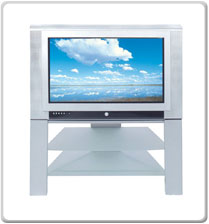Friday, October 27, 2006
A Review on Digital TV Revolution
 The digital TVs that will eventually replace today’s analog system bring a whole new language, leaving consumers who are eyeing or buying new sets scratching their heads. Digital television, or DTV, offers astonishing, super-sharp, widescreen pictures and better quality audio, closer to a theatrical experience. The images are sharper than analog versions because there are more pixels or dots making up the picture. Plus, digital signals can be compressed, so while images are sharper, the same amount of radio spectrum can carry more channels as well.
The digital TVs that will eventually replace today’s analog system bring a whole new language, leaving consumers who are eyeing or buying new sets scratching their heads. Digital television, or DTV, offers astonishing, super-sharp, widescreen pictures and better quality audio, closer to a theatrical experience. The images are sharper than analog versions because there are more pixels or dots making up the picture. Plus, digital signals can be compressed, so while images are sharper, the same amount of radio spectrum can carry more channels as well.Consumers getting ready to invest some $1,000 or more in a new set should know there are three main categories of picture quality with DTVs. Standard-definition is good, enhanced definition is better and highdefinition is the best.
So, HDTV is not the same as DTV and not all DTVs are HDTVs. Before 2005, there wa a mix of EDTV and HDTV sets, especially with plasma flat-panel displays, but these days, many DTV makers are selling mostly HDTV sets, as production costs continue to drop.
Retailers are also getting better at indicating in marketing materials whether a television is HDTV or EDTV. Still, consumers should take note, especially for sets in the lower-price range.
Many Web sites, ranging from those of TV makers and electronics retailers to the government's Federal Communications Commission, offer consumer guides, too. One more thing to note: Although the federal government has mandated a nationwide switch to an all-digital TV system by Feb. 17, 2009, that doesn't mean old, analog TV sets will become obsolete.
Digital converter boxes, whether sold separately or provided through your cable or satellite operator, can be attached to a TV, allowing viewers to get a digital picture — but it won't be able to show high-definition pictures. To get the full benefits of DTV, you'll need a DTV set. And to get highestresolution pictures, you'll need an HDTV. AP
TALKING ABOUT TUBE
Aspect ratio: The width and height of display. A traditional TV is 4x3. Widescreen is 16x9.
Interlace vs progressive scan: Describes how vertical lines are scanned onto a TV picture. Interlace scans all the odd lines first, then instantaneously fills in the even lines. Progressive scans all lines consecutively. The corresponding notation follows the number of lines scanned, such as 480i or 480p.
SDTV (Standard-definition TV): Displays fewer than 480p scan lines in a 16x9 or 4x3 format. This set displays 480i, the same quality as analog TVs. 150,000 to 300,000 pixels.
EDTV (Enhanced-definition TV): A better quality picture with 480 progressively scanned lines, or 480p, which is the quality used by most DVD players. Delivers Dolby digital surround sound. Could be in a 16x9 or 4x3 format. 300,000 to 400,000 pixels.
HDTV (High-definition TV): The highest-resolution of DTVs with a widescreen format and scanning lines of 720p, 1080i or higher. New sets are 1080p. Delivers Dolby digital surround sound. 900,000 to 2.1 million pixels.
HDTV-Ready : Describes TVs that can display high-definition TV but only when connected to a separate HDTV tuner.
Integrated HDTV: An HDTV set that has the digital tuner built in so it can receive over-theair DTV signals without a separate set-top box.


You have given indepth information on Digitabl TV. Very nice.